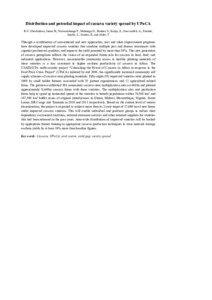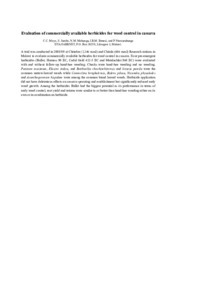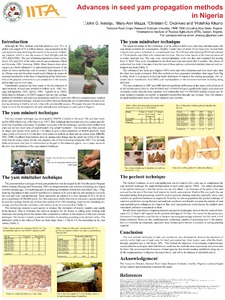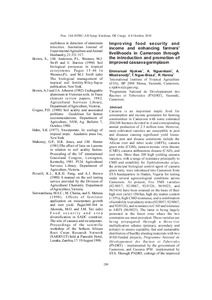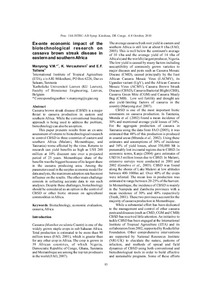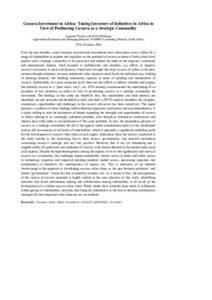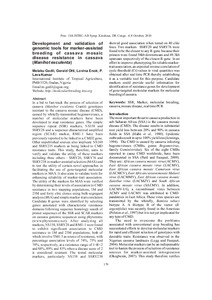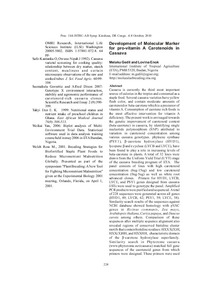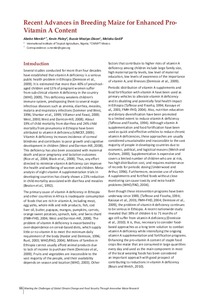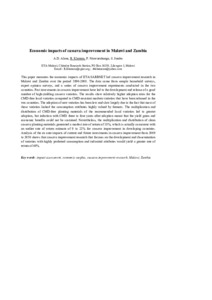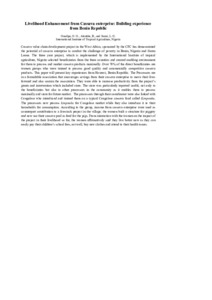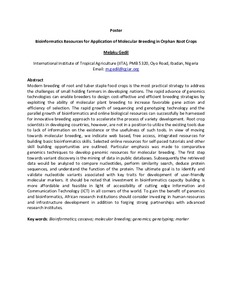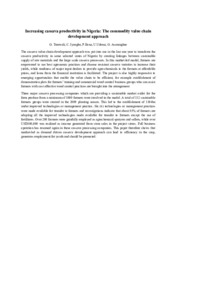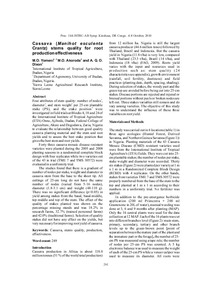Welcome to the International Institute of Tropical Agriculture Research Repository
Conference Documents: Recent submissions
Now showing items 581-597 of 597
-
Distribution and potential impact of cassava variety spread by UPoCA
(International Society For Tropical Root Crops-Africa Branch, 2012-02)Through a combination of conventional and new approaches, root and tuber improvement programs have developed improved cassava varieties that combine multiple pest and disease resistances with superior postharvest qualities, and improve the yield potential by more than 50%. This new generation of cassava germplasm reflects the vision of an expanded future role for cassava in food, feed, and industrial applications. However, unsustainable community access to healthy planting materials of these ... -
Evaluating the effects of UPoCA prior to implementation: taking stock of where we were
(International Society For Tropical Root Crops-Africa Branch, 2012-02)Most development researchers and practitioners agree that the sharp rise in international prices for agricultural commodities that emerged in 2003 and peaked in 2008 resulted in a global food crisis. To combat the crisis, IITA and national partners in seven African countries are evaluating the effects of cassava research for development approach on increasing the productivity of production and processing of cassava for home consumption and marketing surplus produce. This paper uses farm household ... -
Genotype by environment interaction effect on beta-carotene of yellow root cassava (Manihot esculenta Crantz) genotypes in Ghana
(International Association of Hydrological Sciences, 2012-02)Nine yellow root and one white root cassava genotypes were evaluated in ten environments in Ghana for the variability of their beta carotene content in root. The aim was to identify cassava genotypes that have high beta carotene content in storage root to combat the widespread vitamin A deficiency for children under the age of five years and for pregnant and lactating women. This study was conducted in a Randomized Complete Bloc Design with nine yellow root genotypes namely 01/1224; 01/1235; ... -
Evaluation of commercially available herbicides for weed control in cassava
(International Association of Hydrological Sciences, 2012-02)A trial was conducted in 2008/09 at Chitedze (31o 59' S; 33o 38' E) and Chitala (13o 40' S; 34o 15' E) Research stations in Malawi to evaluate commercially available pre-emergent herbicides for weed control in cassava (Manihot esculenta Crantz). Four herbicides, Bullet (chloroacetanilide, dimethanamid, triazine), Harness 90 EC (chloroacetanilide), Codal Gold 412-5 EC (prometryn and S-metolachlor) and Metalachlor 960 EC (S-metolachlor; acetamide), were evaluated with and without follow up hand-hoe ... -
Advances in seed yam propagation methods in Nigeria
(International Society For Tropical Root Crops-Africa Branch, 2012-02)Scarcity and/or high cost of healthy seed yams are the greatest constraints in yam production in Nigeria and probably across the West African Yam belt. Scientists at the National Root Crops Research Umudike developed the yam minisett technique of seed yam production in 1982 but nearly three decades after, the adoption rate of this technology is still below 40%. Concerned about this development, the World Bank mission to Nigeria supervising the National Agricultural Research Projects (NARP) in 1997 ... -
Improving food security and income and enhancing farmers' livelihoods in Cameroon through the introduction and promotion of improved cassava germplasm
(International Association of Hydrological Sciences, 2012-02)Cassava is an important staple food for consumption and income generation for farming communities in Cameroon with some estimated 204,548 hectares devoted to it and corresponding annual production of 2.5 million tons. However, most cultivated varieties are susceptible to pest and diseases causing significant yield losses. Major pest and disease constraints include the African root and tuber scale (ARTS), cassava green mite (CGM), cassava mosaic virus disease (CMD), cassava anthracnose disease ... -
Ex-ante economic impact of the biotechnological research on cassava brown streak disease in eastern and southern Africa
(International Association of Hydrological Sciences, 2012-02)Cassava brown streak disease (CBSD) is a major threat to cassava production in eastern and southern Africa. While the conventional breeding approach is being used to address the problem, biotechnology can also be an option. This paper presents results from an ex-ante assessment of returns to biotechnological research to control CBSD in three countries of eastern and southern Africa (Malawi, Mozambique, and Tanzania) worse affected by the virus. Returns to research can yield benefits as high as US$ ... -
Cassava investment in Africa: taking inventory of initiatives in Africa in view of positioning cassava as a strategic commodity
(ISTRC-AB, 2012-02)Over the past decades, some extensive research and investments have taken place across Africa by a range of stakeholders to explore and capitalize on the potential of cassava in terms of both a basic food product and a strategic commodity to be processed and refined for trade on the regional, continental and international markets. Such research is multifaceted, and includes, e.g. efforts to improve cassava's resistance to pests and diseases, which have ravaged the crops in most of Africa in the ... -
Development and validation of genomic tools for marker-assisted breeding of cassava mosaic disease resistance in cassava (Manihot esculenta)
(International Association of Hydrological Sciences, 2012-02)In a bid to fast-track the process of selection of cassava (Manihot esculenta Crantz) genotypes resistant to the cassava mosaic disease (CMD), caused by whitefly-transmitted begomoviruses, a number of molecular markers have been developed to map resistance genes. The simple sequence repeat (SSR) markers, NS158 and SSRY28 and a sequence-characterized amplified region (SCAR) marker, RME-1 have been previously reported to be linked to a CMD2 gene. Other unpublished sources also implicate NS169 and ... -
Development of molecular marker for pro-vitamin A carotenoids in cassava
(International Society For Tropical Root Crops-Africa Branch, 2012-02)Cassava is currently the third most important source of calories in the tropics and consumed as a staple food. Several cassava varieties have yellow flesh color, and contain moderate amounts of carotenoid or beta-carotene which is a precursor of vitamin A. Consumption of carotene rich foods is the most effective intervention for vitamin A deficiency. The present work is envisaged towards the genetic improvement of carotenoid content (beta-carotene) in cassava, by identifying single nucleotide ... -
Phenotypic evaluation of a multi-location cassava breeding trial to improve a genomic selection training population
(International Association of Hydrological Sciences, 2013-09)Thirty white fleshed cassava genotypes derived from crosses between genotypes from West Africa x East Africa and West Africa x Latin America were evaluated in five major agroecological zones in Nigeria during 2012-2013. The trials were established in a randomized complete block design with four replications. The objectives of the study were (i) to evaluate genotype (G), environment (E), and G X E interaction on cassava mosaic disease (CMD), cassava bacterial blight (CBB), cassava anthracnose disease ... -
Recent advances in breeding maize for enhanced pro-vitamin A content
(The International Maize and Wheat Improvement Center, 2012) -
Economic impacts of cassava improvement in Malawi and Zambia
(International Association of Hydrological Sciences, 2012-02)This paper measures the economic impacts of IITA/SARRNET led cassava improvement research in Malawi and Zambia over the period 1990-2008. The data come from sample household surveys, expert opinion surveys, and a series of cassava improvement experiments conducted in the two countries. Past investments in cassava improvement have led to the development and release of a good number of high-yielding cassava varieties. The results show relatively higher adoption rates for the CMD-free local varieties ... -
Livelihood enhancement from cassava enterprise: building experience from Benin Republic
(The International Society for Tropical Root Crops - Africa Branch, 2012-02)Background: The impact of cassava value chain development has not just been to expand utilization of the crop but also to improve livelihood of the key players especially in the rural sector. This duo benefit is usually achieved through enhanced productivity and capacities of the key players involved. The Common Fund for Commodities (CFC) project focused on this people-oriented approach to improve livelihoods of rural farmers and processors in three selected countries in the West Africa. This is ... -
Bioinformatics resources for application of molecular breeding in orphan root crops
(International Society For Tropical Root Crops-Africa Branch, 2012-02)Modern breeding of root and tuber staple food crops is the most practical strategy to address the challenges of small holding farmers in developing nations. The rapid advance of genomics technologies can enable breeders to design cost effective and efficient breeding strategies by exploiting the ability of molecular plant breeding to increase favorable gene action and efficiency of selection. The rapid growth of sequencing and genotyping technology and the parallel growth of bioinformatics and ... -
Increasing cassava productivity in Nigeria: the commodity value chain development approach
(International Society For Tropical Root Crops-Africa Branch, 2012)The cassava value chain development approach was put into use in the last one year to transform the cassava productivity in some selected states of Nigeria by creating linkages between sustainable supply of raw materials and the large scale cassava processors. In this market-led model, farmers are empowered to use best agronomic practices and disease resistant cassava varieties to increase their yields, while readiness of major input dealers to provide agro-chemicals to the farmers at affordable ... -
Cassava (Manihot esculenta Crantz) stems quality for root production effectiveness
(ISTRC-AB, 2012)Four attributes of stem quality: number of nodes1, diameter2, and stem weight3 per 25-cm plantable stake (PS), and the stake position4 were investigated in field trials at Blocks 4, 18 and 24 of the International Institute of Tropical Agriculture (IITA) Onne, Ajibode, Ibadan, Federal College of Agriculture, Akure and Dogodawa, Zaria, Nigeria to evaluate the relationship between good quality cassava planting material and the stem and root yields and to assess the best stake position that gives the ...

